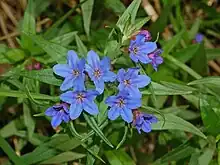| Lithospermum purpurocaeruleum | |
|---|---|
 | |
| Scientific classification | |
| Kingdom: | Plantae |
| Clade: | Tracheophytes |
| Clade: | Angiosperms |
| Clade: | Eudicots |
| Clade: | Asterids |
| Order: | Boraginales |
| Family: | Boraginaceae |
| Genus: | Lithospermum |
| Species: | L. purpurocaeruleum |
| Binomial name | |
| Lithospermum purpurocaeruleum | |
| Synonyms | |
| |
Lithospermum purpurocaeruleum is a synonym for Aegonychon purpurocaeruleum (L.) Holub, also known as the purple gromwell,[1] This plant is a herbaceous perennial rhizomatous flowering plant and it belongs to the family Boraginaceae.
Etymology
The Latin name of the species, purpurocaeruleum, means 'purple and blue', referring to the changing colour of the flowers with the progress of flowering.
Description

Lithospermum purpurocaeruleum is a bushy plant that reaches on average 20–60 centimetres (7.9–23.6 in) of height, with a maximum of 70 centimetres (28 in). The stem is hairy, erect and unbranched. Leaves are dark green and lanceolate to narrow elliptic, with a prominent midrib on the underside. Flowers are hermaphroditic, funnel-shaped, 15–20 millimetres (0.59–0.79 in) long and 10–15 millimetres (0.39–0.59 in) of diameter, clustered in a racemose inflorescence. The flowers are initially purple-reddish, changing to a deep blue. The flowering period extends from April to June. The fruits are bright white capsules, 4–5 millimetres (0.16–0.20 in) long, with a glossy surface. They are very hard (hence the genus synonym Lithospermum, meaning "stone seed" for the hardness of these capsules).
Distribution
This species is rare in British Isles,[2] widespread in central Europe up to South Russia and in Mediterranean countries from Spain to the eastern Turkey.
Habitat
Lithospermum purpurocaeruleum is typically found in dry and warm forests characterized by sparse deciduous vegetation, it can also be found in the meadows situated on the edge of the woodlands, as well as in hedgerows and scrublands. The plants prefer calcareous soils rich in humus, at an altitude of 0–1,800 metres (0–5,906 ft) above sea level.
References
- ↑ "Aegonychon purpurocaeruleum (L.) Holub". Plants of the World Online. Retrieved 4 April 2023.
- ↑ P.A. Stroh; T. A. Humphrey; R.J. Burkmar; O.L. Pescott; D.B. Roy; K.J. Walker (eds.). "Aegonychon purpureocaeruleum (L.) Holub". BSBI Online Plant Atlas 2020. Botanical Society of Britain and Ireland. Retrieved 4 April 2023.
- Pignatti S. - Flora d'Italia – Edagricole – 1982, Vol. II, pag. 398
- Tutin, T.G. et al. - Flora Europaea, second edition - 1993
External links
 Media related to Aegonychon purpurocaeruleum at Wikimedia Commons
Media related to Aegonychon purpurocaeruleum at Wikimedia Commons Data related to Buglossoides purpurocaeruleum at Wikispecies
Data related to Buglossoides purpurocaeruleum at Wikispecies